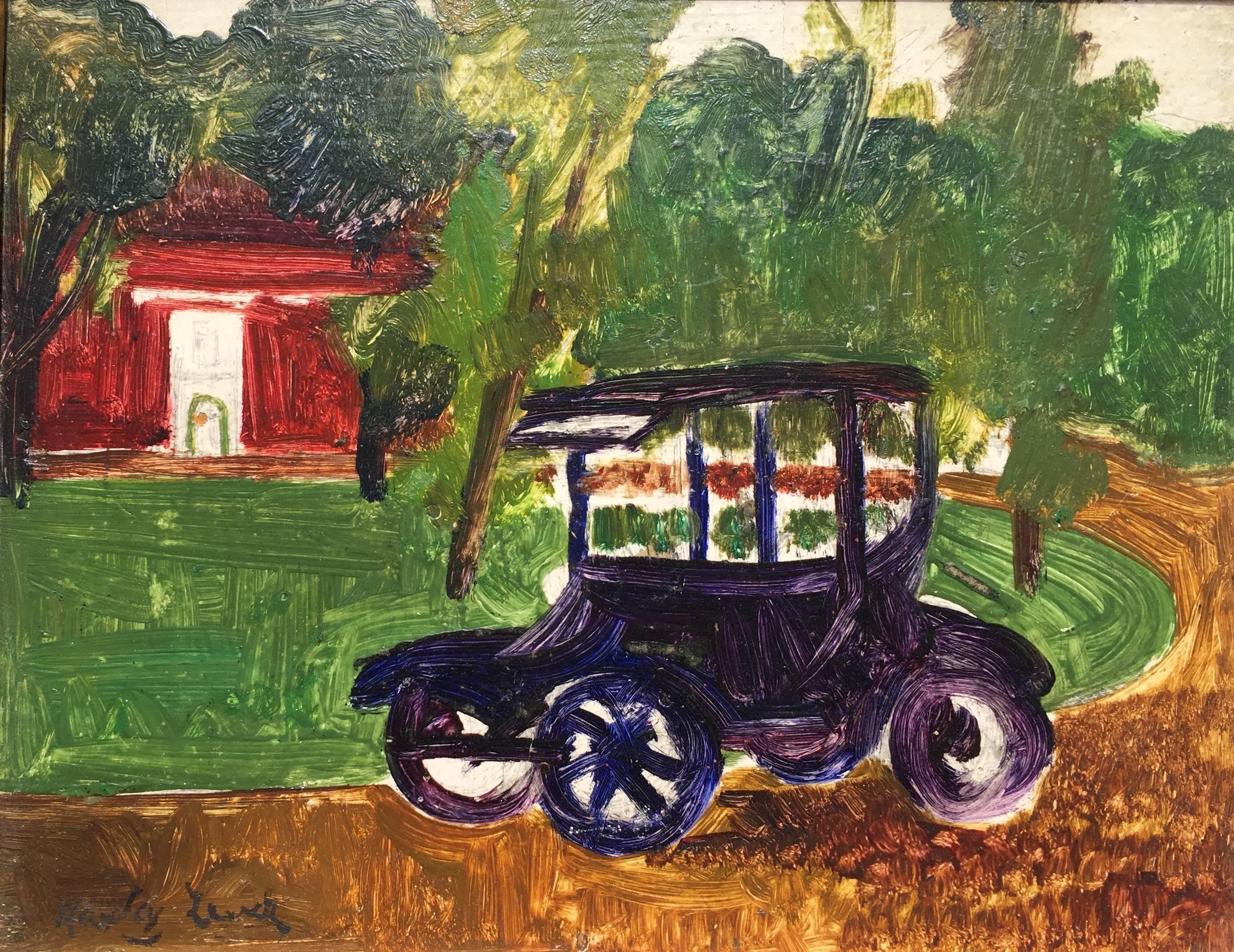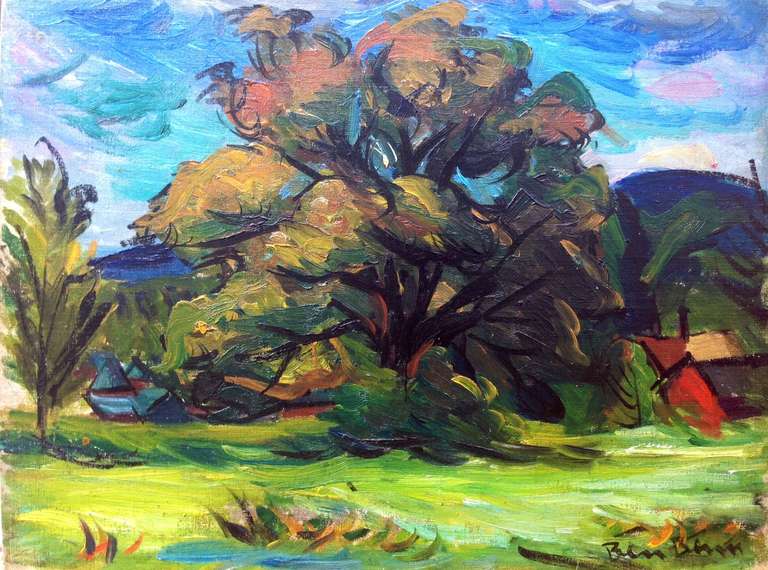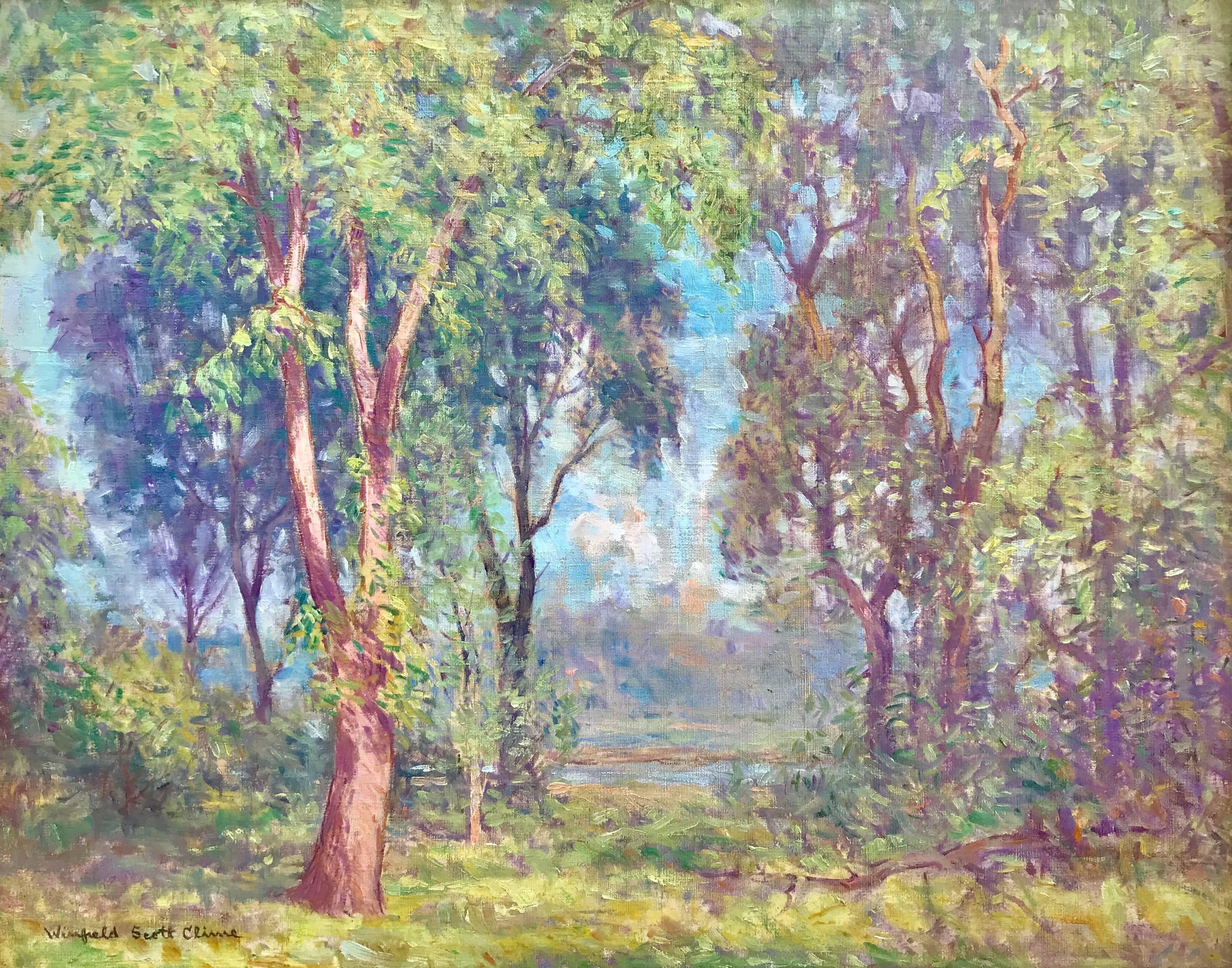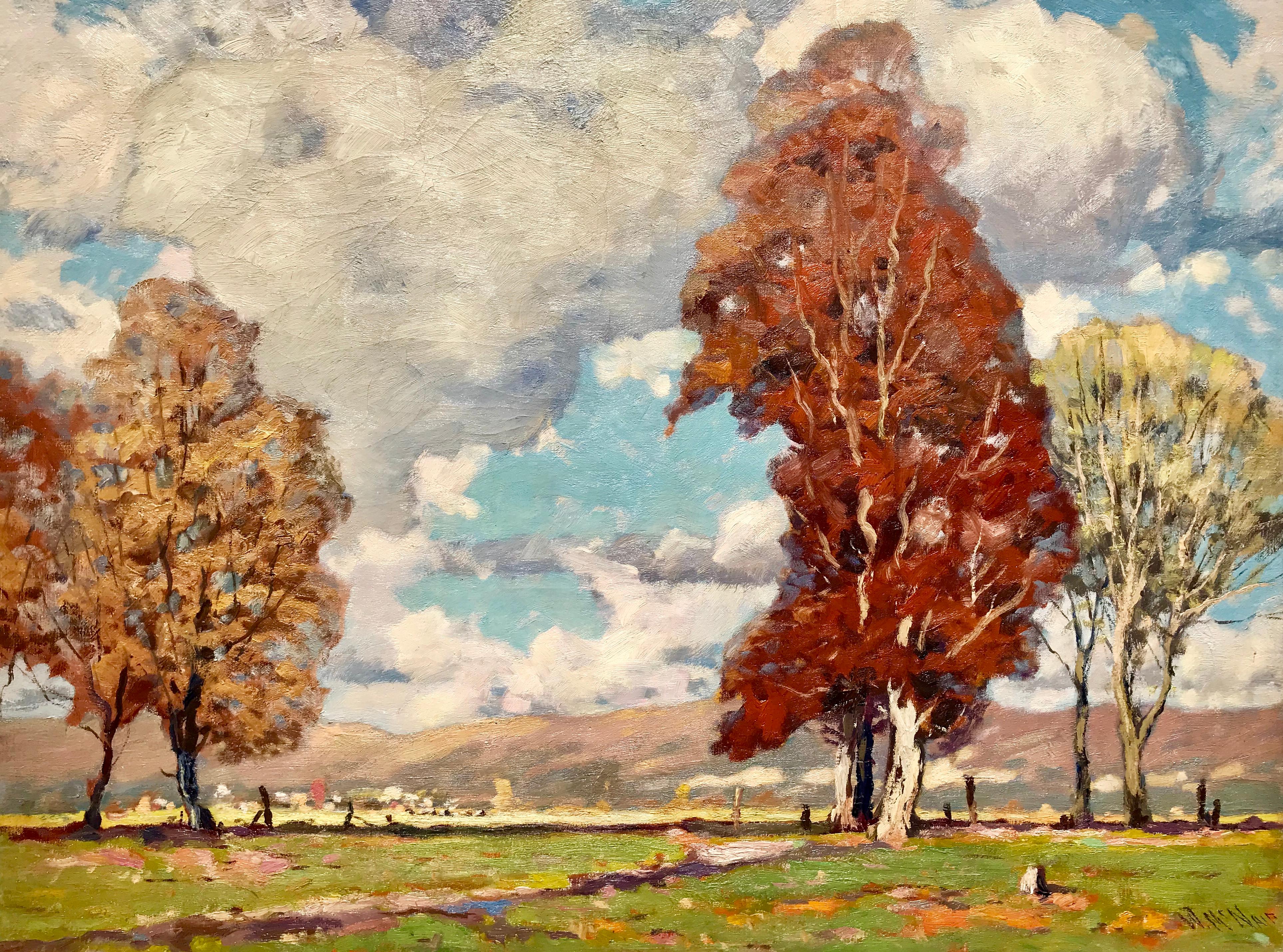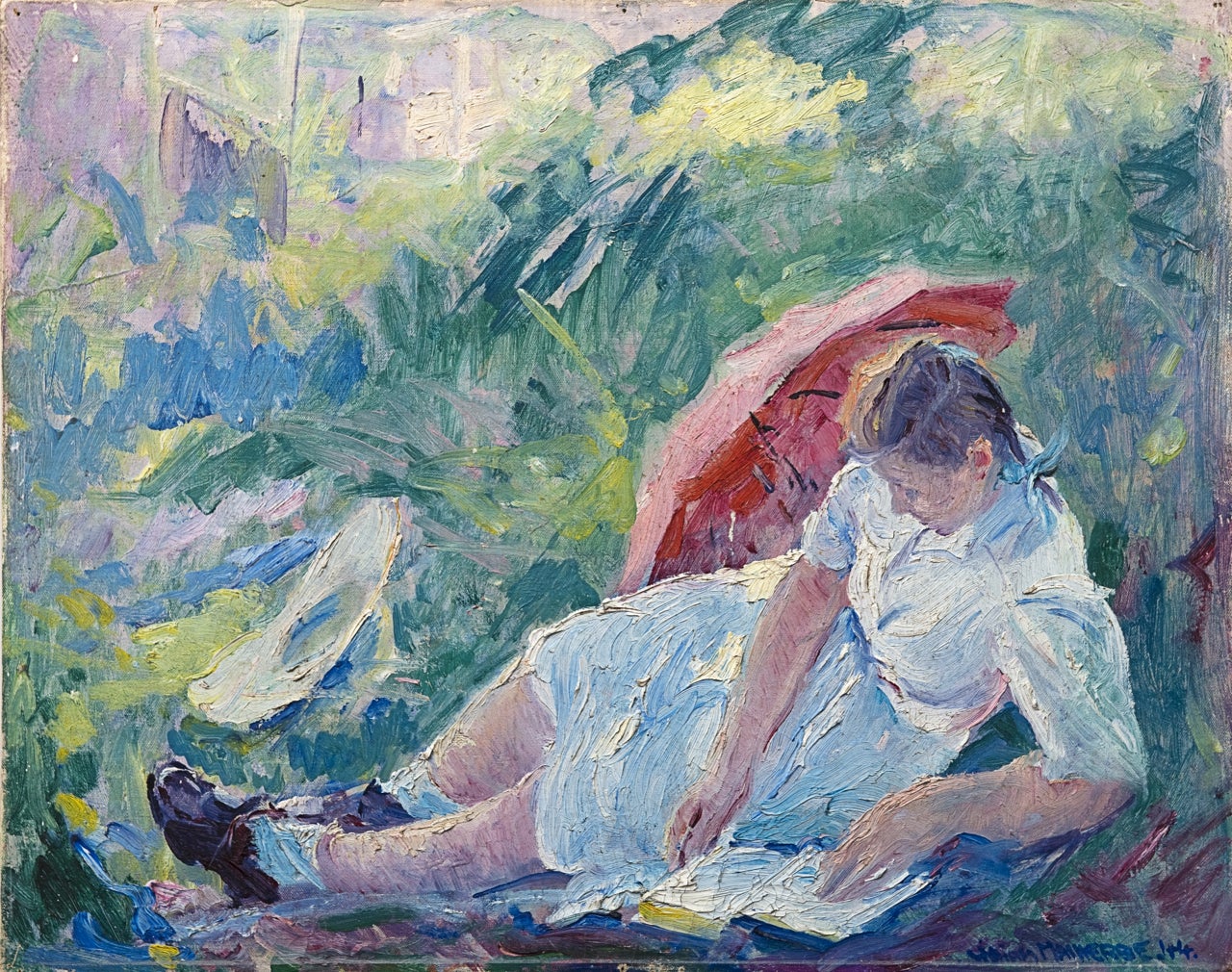Want more images or videos?
Request additional images or videos from the seller
1 of 8
Jean SalabetMoulin Rouge, Paris1954
1954
About the Item
Jean Salabet
French, B. 1900
Moulin Rouge
Jean Salabet was a School of Paris painter know for his colorful Parisian cityscapes.
His work is comparable to those of Jules Herve, Antoine Blanchard and Edouard Cortes.
Juan Bayón Salado, Bay-Sala, J. Bayon, J.B., Jean Salabet (1913-1995)
A Biscayan artist, Juan Bayón Salado (Jean Salabet), was born in Logroño on June 24th, 1913. He died in Bilbao on April 2nd, 1995.
In 1918 he moved to Bilbao. In the early 1930s, he installed his easel at the Bilbao Arenal, where he painted and raffled his paintings among the attendees in order to help his parents. At the time he used to sign as Bayón, and soon after he became a benchmark in the area. According to the painter Manuel de Gracia:
In 1941 he celebrated his first exhibition in Bilbao and a year later he exhibited in Zaragoza, where for the first time he used the pseudonym Bay Sala as signature of his works; that same year he also exhibited his works in Logroño and Bilbao. In 1943 he attended the Exposición Nacional de Bellas Artes with the painting Puerto de Motrico and held exhibitions in Barcelona and Bilbao. Two years later his work La Mina Abandonada was present at the Exposición Nacional de Bellas Artes. That same year he presented himself at the Primera Exposición Provincial de Bellas Artes in Bilbao with the works Riberas Frondosas and La Mina Abandonada and he obtained the Excmo. Ayuntamiento de Bilbao’s gold medal. From that date onwards he hasn’t participated in any other contest.
In 1945 he was a founding partner of the Asociación Artística Vizcaína. In 1948 he participated in the exhibition "35 Paisajes Vascos" at the Witcomb Gallery in Buenos Aires; also making his presentation in Madrid. In the spring of 1950 he set off for Paris, where he settled his residence until the end of 1969 in search of the roots of Impressionism. During those twenty years, as Manuel Lumbreras indicates, he:
"exhibits regularly at the Roussard Gallery in Paris, as well as at the Salon Cano in Madrid and at the former Sala Arte of Bilbao. He is summoned from Buenos Aires and Tokyo and he is selected, along with 35 other artists, to cover the 16th and 17th editions of the Salon de Toile in Paris, together with such eminent artists as Cocteau, Dalí, Dufy, Picasso, Utrillo and Vlaminck, among others. His works become part of the most important international collections around the world."
In 1968 he held exhibitions in Tokyo and Paris. A year later, he returned for good to Bilbao, where he regularly held exhibitions, as well as in Madrid and Barcelona; he also spent long periods painting in Holland, France, Italy, USSR, Belgium and Ireland.
In 1971 his son Juan Bayón opened a small gallery on Iparraguirre street, under the name of Bay Sala, presenting a collective exhibition with the works of A. Alegre, Bardasano, Bay Sala, M. de Gracia, C. Gil, Herráez, Largacha, Luzuriaga, Martínez Díaz, Olaortúa, R. Calpena, J. Quesada and R Sáez. In October 1975, the gallery moved to Licenciado Poza street, 14. The inaugural exhibition of this new space is a tribute to four Basque artists who obtained medals at the Exposiciones Provinciales de Bellas Artes: Bay Sala, Largacha, Merino y Párraga. To this exhibitions followed many individual and collective exhibitions by artist such as Anglada, Benedito, Madrazo, Pradilla, Martín Rico, Lucas Padilla, Marceliano Santa María, C. Pía, Pérez Villamil, Picasso, Grau Sala, Puigdengolas, San Vicens, Millares, Amat, Mallol, Pichot, R. Domingo, Muñoz Degrain or Martínez Vázquez among many others. Among them, Juan Bayón's work is regularly displayed in the gallery.
With a group of painter friends Bay Sala created the talks of "La paleta del Nervión". As a result of this idea, the "Paleta de Oro del Nervión" trophy was created. It is periodically awarded to the most outstanding artists. Among them, Bay Sala himself (1984), Martínez Díaz, Largacha, Juan Manuel Lumbreras and Manuel de Gracia.
In 1985 he was invited to the exhibition "Maestros Actuales de la Pintura Española" for the inauguration of The Embassy gallery in Miami, Florida. In 1991 he was appointed Honorary Fellow of the Asociación Artística Vizcaína. His works are in the Museo de Bellas Artes de Bilbao and in the Museo San Telmo of San Sebastián, among others.
Sources include:
Enciclopedia AuñamendiDictionnaire des Peintres a Montmartre (pp.55-56 ...He signed Salabet, Bay Sala and Bayon)Legacy Copyright Jean SalabetCatalogue Galeria Bay-Sal (J. Salabet- Pseudonym of J. Bay-Sala)
Oil on canvas
10 ½ by 13 ¾ in. W/frame 16 ½ by 19 ½ in.
Signed lower right
Provenance:
Private Collection New York
Le Trianon Fine Art & Antiques
Art S176
$3,600
- Creator:Jean Salabet (French)
- Creation Year:1954
- Dimensions:Height: 16.5 in (41.91 cm)Width: 19.5 in (49.53 cm)Depth: 2 in (5.08 cm)
- Medium:
- Movement & Style:
- Period:
- Condition:
- Gallery Location:Sheffield, MA
- Reference Number:
About the Seller
3.7
Vetted Seller
These experienced sellers undergo a comprehensive evaluation by our team of in-house experts.
1stDibs seller since 2017
46 sales on 1stDibs
Typical response time: Several days
- ShippingRetrieving quote...Ships From: Sheffield, MA
- Return PolicyA return for this item may be initiated within 3 days of delivery.
More From This SellerView All
- Woman in KimonoBy Everett Lloyd BryantLocated in Sheffield, MAEverett Lloyd Bryant American, 1864-1945 Woman in Kimono Oil on canvas Signed lower right 30 by 25 in. W/frame 35 by 30 in. Everett studied wit...Category
1920s Post-Impressionist Figurative Paintings
MaterialsOil
- East River, New York Winter (From Brooklyn Bridge)Located in Sheffield, MAFrank Usher De Voll American, 1873-1941 East River, New York Winter (From Brooklyn Bridge) Oil on canvas 32 by 36 in. w/frame 41 by 45 in. Signe...Category
1910s Post-Impressionist Landscape Paintings
MaterialsOil
- BrittanyLocated in Sheffield, MAEdward Francis Rook American, 1870-1960 Brittany Oil on Canvas 30 by 30 in. W/frame 38 by 38 in. Signed lower left Circa, 1898-1900 Rook, born in New York City on September 21, 1870, became one of the most original impressionists at Old Lyme. First he was a student of Benjamin Constant and Jean-Paul Laurens at the Académie Julian. Life started out to be rather promising for Rook, around the turn of the century. He exhibited at the Cincinnati Art Museum and at the Pennsylvania Academy of the Fine Arts, both in 1898, when his harbor scene, entitled Pearl Clouds — Moonlight was reproduced in International Studio, in April. In addition, the PAFA presented him with the Temple Gold Medal for Deserted Street, Moonlight, which the Academy purchased. Three years later, Rook was awarded a bronze medal at the Pan-American Exposition in Buffalo, where he exhibited three landscapes. Caffin (1902, p. xxxvi) praised the artist's "translucent quality of color," which suggests a study of color theory. Also in 1901, Rook married Edith Sone. For most of 1902, the Rooks were in Mexico. Rook came to Old Lyme in October of 1903. The date is significant because Childe Hassam was also there that month. Hassam would more or less re-orient the artists' colony from Tonalism to impressionism. Rook would move there permanently two years later. He took two medals at the St. Louis Universal Exposition (1904) where his landscapes from the Mexican trip were displayed. More awards followed: a silver medal at the International Fine Arts Exposition in Buenos Aires, 1910, a gold medal at San Francisco's Panama-Pacific International Exposition in 1915, a Corcoran Bronze Medal, and a William A. Clark Award in 1919 for Peonies. By 1924, the artist was made a National Academician. Despite all these awards and recognition, Rook did little in the way of selling his art and reportedly, his prices were too high. His paintings were handled by Macbeth and Grand Central Art Galleries. Rook was active in Old Lyme's art community. As stated above, he would have met Hassam that October in 1903 but Willard Metcalf had departed at the end of the summer. As several writers have explained (Connecticut and American Impressionism, 1980, p. 123), Hassam "was the catalyst around whom [impressionism] coalesced." Rook's niece, Virginia Rook Garver, who happened to be the grand-niece of Hassam, confirmed that Rook and Hassam knew each other in Europe — before they went to Old Lyme (Fischer, 1987, p. 19). Rook was one of the relatively young painters to come to Old Lyme, along with Gifford Beal, William Chadwick, and Robert Nisbet, on the wave of impressionism, initiated there by Hassam and Metcalf. Old Lyme became a center of American impressionism, and as Donelson F. Hoopes remarked, "under Hassam, the shoreline of Connecticut became a kind of Giverny of America." Among Ranger's group, palettes started to become lighter, except those of the most determined tonalists. Ranger himself, perhaps admitting defeat, moved to Noank in 1904. Rook is best known for his views of Bradbury's Mill, which was soon called Rook's Mill, owing to the painter's many versions of the scene. One, called Swirling Waters, dated ca. 1917, is in the Lyme Historical Society. Even more famous is Rook's Laurel, dated between 1905 and 1910 (Florence Griswold Museum), in which a profuse laurel bush (the state flower), is set off by a spectacular Constable-like background. But Swirling Waters could never be confused with Constable, with its violent brushwork, impasto-layered water, and bright, almost chalky, plein-air palette. Gerdts (1984, p. 226) compares the paintings of Walter...Category
1890s Post-Impressionist Landscape Paintings
MaterialsOil
- VUE DU SACRE COEUR - MONTMARTRE, PARISBy Jean SalabetLocated in Sheffield, MAJean Salabet French, 20th Century Vue du Sacre Coeur, Paris Jean Salabet was a School of Paris painter know for his colorful Parisian cityscapes. His work is comparable to those of ...Category
1950s Post-Impressionist Landscape Paintings
MaterialsOil
- Scene de PARIS apres La LiberationBy Lucien AdrionLocated in Sheffield, MALucien Adrion French, 1889-1953 Scene De PARIS apres la Liberation Oil on canvas 21 ¼ in. by 25 ½ in. W/frame 31 ¼ in. by 35 ½ in. Signed & dated 1949 lower right Lucien Adrion w...Category
1940s Post-Impressionist Landscape Paintings
MaterialsOil
- BathersBy John Edward CostiganLocated in Sheffield, MAJohn Edward Costigan, N.A. American, 1888-1972 Bathers Oil on canvas Signed ‘J.E. Costigan N.A.’ lower left 20 by 24 in. W/frame 26 by 30 in. John Costigan was born of Irish-American parents in Providence, Rhode Island, February 29, 1888. He was a cousin of the noted American showman, George M. Cohan, whose parents brought the young Costigan to New York City and was instrumental in starting him on a career in the visual arts. They were less successful in encouraging him to pursue formal studies at the Art Students League (where, however, he later taught) than in exposing him to the commercial art world through the job they had gotten him with the New York lithographing firm that made their theatrical posters. At the H. C. Miner Lithographing Company, Costigan worked his way up from his entry job as a pressroom helper, through various apprenticeships, to the position of sketch artist. In the latter capacity he was an uncredited designer of posters for the Ziegfeld Follies and for numerous silent films. Meanwhile, he had supplemented his very meager formal studies in the fine arts with a self-teaching discipline that led to his first professional recognition in 1920 with the receipt of prizes for an oil painting and watercolor in separate New York exhibitions. A year earlier, Costigan had wed professional model Ida Blessin, with whom he established residence and began raising a family in the sleepy little rural New York hamlet of Orangeburg, the setting for the many idyllic farm landscapes and wood interiors with which he was to become identified in a career that would span half a century. John Costigan’s first national recognition came in 1922 with his winning of the coveted Peterson Purchase prize of the Art Institute of Chicago for an oil on canvas, “Sheep at the Brook.” It marked the start of an unbroken winning streak that would gain him at least one important prize per year for the remainder of the decade. The nation’s art journalists and critics began to take notice, making him the recurring subject of newspaper features and magazine articles. The eminent author and critic Edgar Holger Cahill was just a fledgling reporter when he wrote his first feature, “John Costigan Carries the Flame,” for Shadowland Magazine in 1922. Costigan had his first one-man show of paintings at the Rehn Gallery on New York’s 5th Avenue in November, 1924, to be followed less than three years later by another at the Art Institute of Chicago. In addition, Costigan’s work has been—and continues to be included, side-by-side with that of some of America’s most high-profile artists, in museum and gallery exhibitions throughout the country. His renown had peaked in the early 1930s, by which time his work had been honored with nearly every major award then being bestowed in the fine arts and had been acquired for the permanent collections of several prestigious American museums, including New York’s Metropolitan (which only recently, in 1997, deaccessioned his “Wood Interior,” acquired in 1934). Although Costigan’s celebrity had ebbed by the late 1930s, the Smithsonian Institution saw fit in 1937 to host an exhibition exclusively of his etchings. And, in 1941, the Corcoran Gallery (also Washington, D.C.) similarly honored him for his watercolors. (Another Washington institution, the Library of Congress, today includes 22 Costigan etchings and lithographs in its permanent print collection.) During World War II, Costigan returned briefly to illustrating, mainly for Bluebook, a men’s pulp adventure magazine. A gradual revival of interest in his more serious work began at the end of the war, culminating in 1968 with the mounting of a 50-year Costigan retrospective at the Paine Art Center and Arboretum in Oshkosh, Wisconsin. Oils, watercolors and prints were borrowed from museums and private collections throughout the country, and the exhibition was subsequently toured nationally by the Smithsonian Institution. John Costigan died of pneumonia in Nyack, NY, August 5, 1972, just months after receiving his final prestigious award —the Benjamin West Clinedinst Medal of the Artist’s Fellowship, Inc., presented in general recognition of his “...achievement of exceptional artistic merit...” in the various media he had mastered in the course of his career. This painting depicts one of the artist's favorite themes --the farm family bathing...Category
1950s Post-Impressionist Figurative Paintings
MaterialsOil
You May Also Like
- "Model A Ford"By Hayley LeverLocated in Southampton, NYHere for your consideration is a wonderful whimsical oil on wood panel painting by Richard Hayley Lever. In this painting Lever captures our fancy with his depiction of one of Henry...Category
1930s Post-Impressionist Landscape Paintings
MaterialsBoard, Oil
- "Osyter Bay, New York"By Thomas CardoneLocated in Southampton, NYOil on board painting of a boatyard in winter in Oyster Bay, Long Island. Signed lower right. Signed, titled and dated 2010 verso. Framed in custom gold leaf gallery frame 19 by 22 ...Category
2010s Post-Impressionist Landscape Paintings
MaterialsOil, Board
- "Woodstock, New York"By Ben BennLocated in Southampton, NYOriginal oil on artist board painting by the Russian/American artist Ben Benn. Signed lower right and signed titled and dated in pencil verso. 1929. Overall in custom contemporary ...Category
1920s Fauvist Landscape Paintings
MaterialsOil, Board
- “Woodland Vista”By Winfield Scott ClimeLocated in Southampton, NYOil on artist board painting by the American artist, Winfield Scott Clime. Signed lower left. Titled verso. Partial Lyme Association exhibition label verso. In good condition. Frame...Category
1930s Post-Impressionist Landscape Paintings
MaterialsOil, Board
- “Pennsylvania Panoramic”By William McNairLocated in Southampton, NYOil on canvas painting of a Pennsylvania country scene by the American artist, William McNair. Signed lower right. Condition: Very good.. Old reline. Overall measurement framed 35.5 ...Category
1910s Post-Impressionist Landscape Paintings
MaterialsCanvas, Oil
- "Reclining Girl with Parasol"By William MalherbeLocated in Southampton, NYSigned lower right dated 1944 Signed verso William Malherbe "The Thetford Hill Vermont" Provenance: Palm Beach Galleries Framed in a gold frameCategory
1940s Post-Impressionist Paintings
MaterialsOil, Board
